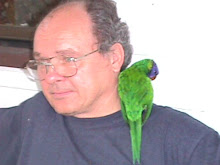Now that was a long weekend!
We all have our own slings and shots that cause us to tarry along life’s highway. Among mine over the past few weeks has been school. More precisely, testing, marking and collating a mountain of data on which to base report cards. The days when a teacher could simply write “Could do better” or “Working well” have gone. I’m not complaining, merely informing.
But I’m back.

It would be gratifying to report that while I was buried beneath an avalanche of test papers the birds merely got on with whatever it is birds do when their human observers are occupied elsewhere. And it might be that that s exactly what they were doing but…
The Yellow-faced Honeyeater Lichenostomus chrysops which seemed to be making a welcomed comeback only weeks ago has again disappeared. Admittedly our observations have been limited to brief weekend windows but at one point back there we could here this bird when simply lying in bed.
It rival, the Blue-faced Honeyeater Entomyzon cyanotis, while still flitting between north and south feeders, is greatly reduced in numbers.
The Sulphur-crested Cockatoos Cacatua galerita had been on the decline for some time but now only occasionally fly by overhead. Perhaps even more alarming is the apparent disappearance of our Galahs Eolophus roseicapillus. They had, at one time, made regular appearances at poultry-feeding time; there would be anything up to 30 specimens competing with the Silver-grey Dorkings for the scattered mixed grain.
We all have our own slings and shots that cause us to tarry along life’s highway. Among mine over the past few weeks has been school. More precisely, testing, marking and collating a mountain of data on which to base report cards. The days when a teacher could simply write “Could do better” or “Working well” have gone. I’m not complaining, merely informing.
But I’m back.

It would be gratifying to report that while I was buried beneath an avalanche of test papers the birds merely got on with whatever it is birds do when their human observers are occupied elsewhere. And it might be that that s exactly what they were doing but…
The Yellow-faced Honeyeater Lichenostomus chrysops which seemed to be making a welcomed comeback only weeks ago has again disappeared. Admittedly our observations have been limited to brief weekend windows but at one point back there we could here this bird when simply lying in bed.
It rival, the Blue-faced Honeyeater Entomyzon cyanotis, while still flitting between north and south feeders, is greatly reduced in numbers.
The Sulphur-crested Cockatoos Cacatua galerita had been on the decline for some time but now only occasionally fly by overhead. Perhaps even more alarming is the apparent disappearance of our Galahs Eolophus roseicapillus. They had, at one time, made regular appearances at poultry-feeding time; there would be anything up to 30 specimens competing with the Silver-grey Dorkings for the scattered mixed grain.

We noted a pair flying through overhead yesterday.
It’s puzzling, it’s concerning but hopefully it is no more than an avian reaction to the bitterly cold winter snap we are currently experiencing in the South Burnett region. It bottomed out at 5.5 Celsius the other day and it can get even colder in August!
On the other hand, we seem to have acquired a friendly male Australian Magpie Cracticus tibicen. It has been coming around for some time now. We first noticed him on one of the occasions when the local Grey Butcherbirds Cracticus torquatus arrived on the verandah rail for its usual feed of cheese. We tend to toss small fragments into the air to enjoy the aerobatics of the butcherbirds as they take the morsel in mid air. On the odd occasion the butcherbirds miss the proffered titbit which lands on the verandah decking. It was on one of these instances that we first noted the magpie. It suddenly swooped in, gathered up the piece of cheese and flew off into the nearby angophora.
Nowadays it will readily take split dog biscuit crumbs and indeed can often be seen in the 40x25m dog compound pecking at unguarded old bones in search of some overlooked fragment of meat. We have observed the magpies actually carry off an entire segment of wizened bone.
Yesterday, Fay had it taking cheese out of her hand!
It’s puzzling, it’s concerning but hopefully it is no more than an avian reaction to the bitterly cold winter snap we are currently experiencing in the South Burnett region. It bottomed out at 5.5 Celsius the other day and it can get even colder in August!
On the other hand, we seem to have acquired a friendly male Australian Magpie Cracticus tibicen. It has been coming around for some time now. We first noticed him on one of the occasions when the local Grey Butcherbirds Cracticus torquatus arrived on the verandah rail for its usual feed of cheese. We tend to toss small fragments into the air to enjoy the aerobatics of the butcherbirds as they take the morsel in mid air. On the odd occasion the butcherbirds miss the proffered titbit which lands on the verandah decking. It was on one of these instances that we first noted the magpie. It suddenly swooped in, gathered up the piece of cheese and flew off into the nearby angophora.
Nowadays it will readily take split dog biscuit crumbs and indeed can often be seen in the 40x25m dog compound pecking at unguarded old bones in search of some overlooked fragment of meat. We have observed the magpies actually carry off an entire segment of wizened bone.
Yesterday, Fay had it taking cheese out of her hand!

No comments:
Post a Comment